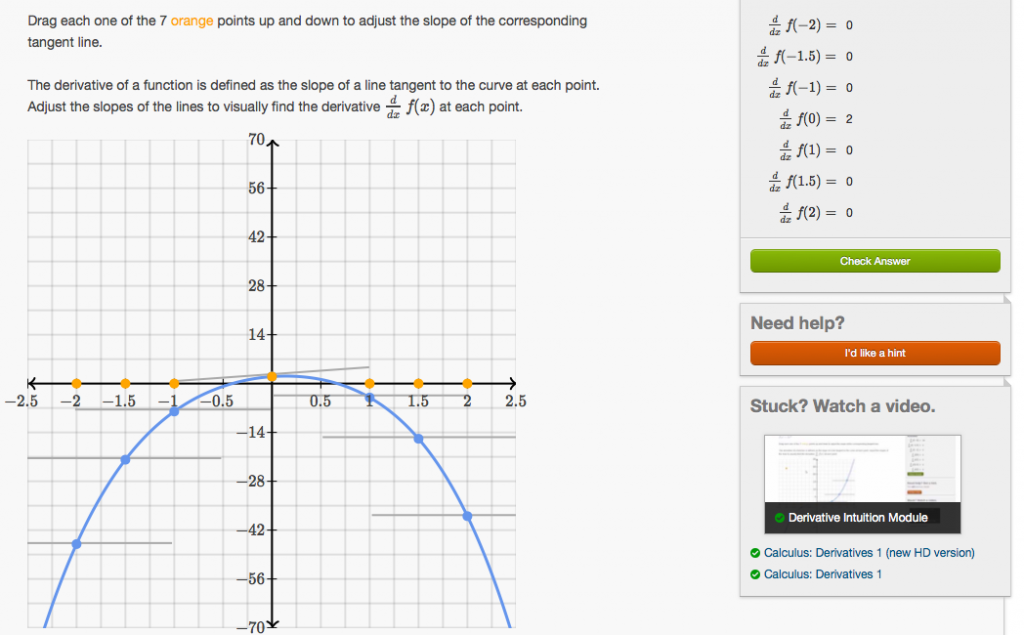
By now, you’ve probably heard of the Khan Academy. It started as a few youtube videos that offered help on math homework and it’s grown to a phenomenon that caught the attention (and money) of Bill Gates. Most of us have been burned by the push to use technology in the math classroom, and honestly the Khan Academy is not free from danger; however, it does offer us pedagogical opportunities that were impossible before. I have used the site extensively, and I would like to share some of my experience to help you use it effectively and smoothly.
The site has two main components: videos and exercises.
Videos
There are over 3200 videos on the site, including videos about the historical origins of algebra, the modern financial crisis, natural and computer science, and lots and lots of math. All of the videos are created by Salman “Sal” Khan, except for a few recent additions from the exciting Vi Hart. Despite almost never seeing Sal’s face, the videos feel personal, almost intimate. Sal’s videos are extremely traditional lectures, he subtly disrespects or devalues proof, and they are not error free, but the video library offers some possibilities that are not present in the classroom. The students can pause and re-watch any portion of the current video. The students can review prerequisite material without feeling ashamed. And the students can watch a “lecture” in preparation for classtime. This last possibility is sometimes called “flipping the classroom”, and Sal does a good job of explain this groundswell in his TED talk.
Exercises
The other main component of the Khan Academy is the BRILLIANT set of exercises. The exercises are organized into topics and also placed into a flowchart that starts with addition of single-digit positive integers and includes some Calculus. If a student starts from the top of the flowchart, the Academy will make suggestions of new topics for which the student has mastered the prerequisite exercises. Each exercise generates a collection of problems of 1-4 types that work on the same skill or concept; the numbers and types are randomized pretty well.
The exercises provide immediate feedback, and they offer a very nice set of “Hints” that step a student through a solution. If the student uses the hints, s/he will not receive full credit on the item. The exercises are geared toward mastery through a complex energy-bar system. In short, if a user makes an error or uses a hint, s/he must get several questions in a row correct to reach mastery. If the user can get the first 8 questions in an exercise correct without hints, s/he will achieve mastery. Students can find the focus on mastery frustrating; they are used to answering a question and moving on, but now they know that they are wrong and that they must keep trying. It’s pretty easy to mis-type an answer and give yourself more work. The system also demands reduced fractions in places that are inappropriate, which frustrates me. In addition to the solution hints, there are links to the videos related to the exercise, which appear in pop-up windows. Watching these videos does not count as a hint, and I think it encourages the right kind of behavior. If you return to the site about a week after mastering a topic, it will start suggesting that you review it. This essentially generates a pop-quiz from the mastered topics, and it seems to have a preference for those with more errors.
Most of the exercises train extremely computational or procedural skills. Never think that the skills tested are enough for a course; but they can help with the lower-level goals. And some of the videos offer students opportunities or experiences that are hard in class for the expert and impossible for students at home. Most of the “Intuition” exercises are creative in this way. My favorite is “Derivative Intuition“, in which the user simultaneously manipulates slopes of tangent lines and points on the graph of the derivative.

The exercise dashboard has running tally of points, a collection of achievement “badges”, and choices of avatars based on the points. Khan has seen these elements encourage and direct the energies of middle schoolers, but it works on me too. Users can add “coaches” and goals, and the site allows coaches to make groups and see useful analytics about the users they are coaching.
In short, I think the Khan Academy can help us move some of the procedural work outside of the classroom, leaving more room for more critical thinking during precious classtime. I think it’s a great resource for underprepared students that won’t require you to reteach previous courses entirely, and I think it could even be used either as a placement test or as a way to identify those students who will struggle well before the first test.
